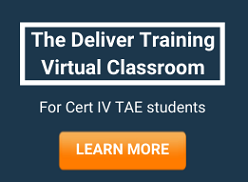About this unit.
This unit specifies the outcomes required to use work effectively as a learning process.
The full Unit of Competency is available here.
Table of contents:
- Clarify the Purpose of the Learning Program
- Confirming the Content of our Learning Program
- Writing Learning Objectives
- Using the SMART Formula to Write Objectives
- Other People & Operational Factors Influence our Learning Strategy
- Evaluate Work Practices and Routines
- Develop Possible Learning Strategies
- Internal and External Training
- Using Criteria to Evaluate Work-Based Learning Programs
- Learner Needs Influence the Learning Strategy
- Explaining What’s Involved
- Synchronise Processes and Support at Work
- Strategies to Support Workplace Learning
- Collaborating With Others
- Access and Equity Policies
- Determine Readiness & Monitor Progress
- Encouraging Individuals
- Drawing Out Learner Understanding
- Feedback
- Delivery Record Keeping
- Seeking Feedback
- Reviewing the Program
- Reviewing Work-Based Learning
This unit includes the following elements and performance criteria.
Element 1. Establish an effective work environment for learning
1.1 The purpose or objectives of the work- based learning are established and agreed with appropriate personnel
1.2 The areas of work encompassed by the work-based learning are defined and documented
1.3 Work practices and routines are analysed to determine their effectiveness in meeting the work-based learning objectives
1.4 Changes are proposed to work practices, routines and the work environment to support more effective learning, where appropriate, and discussed with relevant persons
1.5 Workplace Health and Safety (WHS) and industrial relations implications of using work as the basis for learning are identified and addressed
Element 2. Develop a work based learning pathway
2.1 The documented work areas are analysed to determine an effective work- based learning pathway
2.2 Organisational strategies to support the work-based learning are proposed
2.3 Any contractual requirements and responsibilities for learning at work are addressed
2.4 Connections are made with the training and/or assessment organisation to integrate and monitor the external learning activities with the work-based learning pathway where relevant
2.5 The proposed work-based learning pathway is evaluated against appropriate criteria
2.6 Agreement is obtained from relevant personnel to implement the work-based learning pathway
Element 3. Implement the work based learning pathway
3.1 The learners' profile and characteristics are evaluated to determine possible requirements for support
3.2 The purposes/objectives for undertaking work-based learning and the processes involved are clearly explained to the learners
3.3 The introduction of workplace tasks, activities and processes is sequenced to reflect the agreed work-based learning pathway
3.4 Agreed organisational strategies are put into effect
3.5 Relations with other work personnel affected by the work-based learning pathway are managed to ensure effective implementation
3.6 Appropriate communication and interpersonal skills are used to develop a collaborative relationship with learners
Element 4. Monitor learning and address barriers to effective participation
4.1 Access and equity considerations are addressed, where appropriate
4.2 The readiness of the worker to participate in and/or take on new tasks and responsibilities is effectively monitored
4.3 Work performances are observed and alternative approaches suggested where needed
4.4 Learners are encouraged to take responsibility for learning and to self-reflect
4.5 Techniques for learners to demonstrate transferability of skills and knowledge are developed
4.6 WHS requirements are monitored to ensure health, safety and welfare
4.7 Feedback is provided to learners about work performance and success is communicated and acknowledged
Element 5. Review the effectiveness of the work based learning pathway
5.1 Work performance and learning achievement are documented and recorded in accordance with legal/organisational requirements
5.2 Learners are encouraged to provide critical feedback on their learning experiences
5.3 The effectiveness of the work-based pathway is evaluated against the objectives, processes and models used
5.4 The effectiveness of any integration of work-based learning and external learning activities is assessed
5.5 Improvements and changes to work-based practice are recommended in light of the review process









